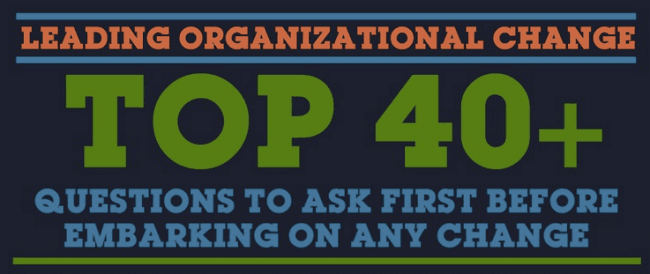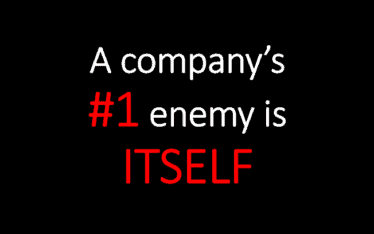Organizations will not change if people do not change
Change is a constant in business today – in fact, it’s the only thing that’s guaranteed! Yet, if it’s so common, why do so many organizations get it wrong? The vast majority of companies continue to just hope that employees of their change initiatives will simply embrace the changes thrust upon them. But that approach hardly ever works.
Organizations don’t change, people change
One of the biggest mistakes you can make in initiating major company changes is to expect that everyone’s reaction will be even remotely like yours. Regardless of the catalyst for the change, it will be your employees who determine whether it successfully achieves its desired outcome.
Organizations don’t change. People do – or they don’t. If employees don’t trust leadership, don’t share the organization’s vision, don’t buy into the reason for change – there will be no successful change – regardless of how brilliant the strategy.
You can’t lead change if you don’t understand your employees. And the best way to do that is to start thinking like your employees. So better start asking yourself these questions:
#1 – Do I understand why change is necessary?
Failure to create a sense of urgency causes a change movement to lose momentum before it gets a chance to start. Establishing a true sense of urgency without creating an emergency is the first objective achieved to overcome the routine of daily business.
#2 – Do I feel the problem?
Before you can get buy-in, people need to feel the problem. People aren’t going to consider anything until they are convinced there is a problem that truly needs to be addressed.
Time and communication are the two keys to success for the changes to occur. People need time to understand the changes and they also need to feel highly connected to the organization throughout the transition period. When you are managing change, this can require a great deal of time and effort and hands-on management is usually the best approach.
#3 – Do I resist the change?
Understanding the most common reasons people object to change gives you the opportunity to plan your change strategy to address these factors.
In order to accept the change and contribute to making the change successful, people need to understand how the changes will benefit them. Not everyone will fall in line just because the change is necessary and will benefit the company. This is a common assumption and pitfall that should be avoided.
#4 – Do I support the change efforts?
So if your approach to initiating changes has been to assume that a single message, a single person, or even a single group is going to make change happen, I highly recommend that you pause for a moment and look to see whether you have one, healthy, change-ready company, or whether you may have warring tribes that are about to destroy one another amid forced change.
#5 – Do I feel involved?
Whenever an organization imposes new things on people there will be difficulties. Participation, involvement and open, early, full communication are the important factors
#6 – Do I feel informed about the change progress?
People in the organization may need to hear a message over and over before they believe that this time, the call for change is not just a whim or a passing fancy. It takes time for people to hear, understand, and believe the message. So better make sure that the internal communication is on the top of the agenda: Communication is paramount when it comes to change management – Lots of it.
#7 – Do I lose face?
By definition, change is a departure from the past. Those people associated with the last version – the one that didn’t work, or the one that’s being superseded – are likely to be defensive about it. When change involves a big shift of strategic direction, the people responsible for the previous direction dread the perception that they must have been wrong. Leaders can help people maintain dignity by celebrating those elements of the past that are worth honoring, and making it clear that the world has changed. That makes it easier to let go and move on.
#8 – Do I loos control?
Change interferes with autonomy and can make people feel that they’ve lost control over their territory. It’s not just political, as in who has the power. Our sense of self-determination is often the first things to go when faced with a potential change coming from someone else. Smart leaders leave room for those affected by change to make choices. They invite others into the planning, giving them ownership.
#9 – Do I think there are too many changes?
Change is meant to bring something different, but how different? We are creatures of habit. Routines become automatic, but change jolts us into consciousness, sometimes in uncomfortable ways. Too many differences can be distracting or confusing. Leaders should try to minimize the number of unrelated differences introduced by a central change. Wherever possible keep things familiar. Remain focused on the important things; avoid change for the sake of change.
#10 – Do I have the right competencies?
Can I do it? Change is resisted when it makes people feel stupid. They might express skepticism about whether the new software version will work or whether digital journalism is really an improvement, but down deep they are worried that their skills will be obsolete. Leaders should over-invest in structural reassurance, providing abundant information, education, training, mentors, and support systems. A period of overlap, running two systems simultaneously, helps ease transitions.
#11 – Do I know what success would look like?
Ask them to envision what success would look like and what it would take to get there. With enough of these conversations, you might enlist them in making the change happen, rather than preventing it.
Change management mistakes to avoid
Deciding what to change is one thing. Making changes stick is another. To improve your odds, use this change management checklist:
Organizations don’t change. People do – or they don’t — https://www.torbenrick.eu/t/r/xxw
Share it:
If you enjoyed this article, please take 5 seconds to share it on your social network. Thanks!










An excellent insight and so true. Going back to the question; “Do you need to think like an employee?” – Yes. it helps. But you absolutely need to embrace the employees and articulate the change long before implementation. Leadership and change is about taking the people with you along the journey. Not announcing the departure and the destination to find out that no one has booked their place ! Change is what occurs through people, not what we “do” to people. Quite often politics and personal interest can preclude real success. Change is about addressing, defusing and managing to reduce (Or eliminate) such distractions, to enable the correct focus of energies to faciliate true stakeholder partic[pation and the wider strategic and tactical implementaion of change. – Paul Lampey
Great comments Paul – Thanks
When I read the headline, I was faced with some experiences I made last Friday.
Organisations do not, but people change? But why? My question is, why it seems to be so difficult, that organisations do not change or even it is so difficult, that they are able to change – to develop?
Last Friday I discussed a fundamental problem of Human Resources and Development. It was a discussion which was not open and orientated on development. It was a discussion to settle the old, despite the Management Board decided some strategic issues. And my point in this meeting was: If the company have to change, do they need more of the old things or more of the new things? Do they need experience how to manage change or do they need experience how to held standard trainings?
Across the table where persons in charge with the duty to transform board decisions into real, the duty to support the board to make decisions understandable.
For them it was essential to argue, that they need people in management development who are busy in the same service sector for years and especially experienced in ordinary standardised trainings. Obviously, they did not need people who are familiar in these change processes, especially for executive managers. Shocking! Inconveivable, if you remember that the Management Board decided to create a learning organisation, to learn form best practises and to do this together with all the managers in the different branches of this service company. By the way: The work council nodded his head, when I pointed this discrepancy out.
Therefore, I think, your questions are the questions in fact and very important! But I still believe, that there is the most important duty of Human Resources and Development to answer these questions and transform them into the development of companies, to support people (managers, too) to change. Many of these Human Resources Departments are unable to lead the process, because they are old fashioned in the way of their view what change needs.
And at last: So many wise books where written over the last decade on change and it seems, that so many companies changes, despite of Human Resources as I described. – Reiner Doberschütz
Organisations can change but it’s extremely difficult, as all organisations must face their culture if they want their change programme to be successful.
I think of culture like the prevailing wind, constantly blowing and over many years can bend a tree to grow sideways! You can’t see it but it is immensely powerful and to change it or it’s impact is almost impossible. But it is possible!
I see the following factors as the keys to understanding organisational culture:
1. The founder of the business
2. The current head of the business
3. The previous head of the business
4. Your business model
5. The nature of your business
When you understand these forces at play in every organisation, you can start to address them.
I think this is s very interesting subject matter and could go on but clocks ticking!
Regards
SPENCER
Rick, Great post! you raise a number of critical factors for leaders to consider as they plan for, and execute, change. I would suggest one “add” to your second point, “Do I feel the problem?” Sometimes, the problem isn’t a problem…the change is driven by an opportunity that you can’t afford to miss. (If you miss the opportunity and your competitors don’t…then you have a problem.”
Great article Torben, exactly as if coming from my conviction. And agree also to Brian Gorman’s addition; in my view an essential point. A leader needs to have these skills instead of copying scenario’s from his/her MBA tutorial, just for the sake to appear a ‘dynamic manager’. Have seen too many do that. Full awareness and proper understanding of one’s organisation (within its setting) is the only remedy to fulfil those requirements that you (rightly) sum up.
-Michael
Great article. The role of change leader is facilitator not dictator – it’s critical we empower employees and leaders through the process to make decisions, establish protocols and create solutions to problems they forsee; “Change interferes with autonomy and can make people feel that they’ve lost control over their territory. It’s not just political, as in who has the power. Our sense of self-determination is often the first things to go when faced with a potential change coming from someone else. Smart leaders leave room for those affected by change to make choices.”